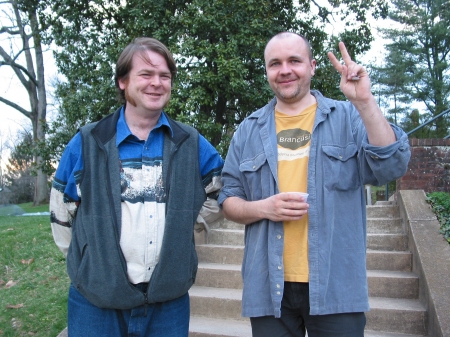|
|
|
|||||



|
"Digital art in its broadest definition graces the Fayerweather Gallery at the University of Virginia, all the art there pieced together through an international exchange of ideas. In some cases, that electronic mail correspondence is the only thing "digital" about the art. Students have created everything from prints to sculpture to film for the "Panorama" show. Visiting professor Bogdan Achimescu used his connections at home in Poland to initiate a semester-long exchange between his Studio Art classes and students at the Fine Arts Academy in Krakow.  The idea for the show came last summer, championed by William Bennett, head of the Studio Art department. Some projects went as planned, others did not. One piece by Susan Layette is a collage of crumpled computer print-outs documenting a failure of both artistic and linguistic communication between the Virginia student and her Polish counterpart. "Panorama" is unlike other student art shows for reasons beyond this creative diplomacy. The culminating events on April 10 and 11 will feature multimedia presentations by Arthur Tajber, Brian Kennedy and John W. Ford - world-renowned artists and part of the "international school of loose affiliation," according to Achimescu. His students won this rare opportunity by coincidence. A show "Re-imagining Ireland" is coming to U. Va. next month, and Kennedy will be installing a glass sculpture at the adjacent Bayley Art Museum. Through the "loose affiliation," the Polish Tajber, who heads the new media department at the Krakow academy, and American Ford have put "Panorama" on the map, and Achimescu is a little jealous. "This show will travel to Poland (after its three-week, Fayerweather run) and the class's work will be shown in a gallery in the middle of a city where professional artists could not have dreamed of getting," he said. But other than the instant notoriety, the U. Va. students have not had it easy. Their teaches wanted "Panorama" to serve as a lesson in reality , as well, by stripping away all the support they might have expected for project on this scale. Achimescu made then work like professionals not students. "In addition to producing the work, they've had a lot of responsibilities,' he said. "In a real-work exhibition, they would not have managers, photographers, sound engineers, secretaries... they're learning all kinds of real-life survival." Tajber himself will have the humbling duty of carrying prints from the show as carry-on luggage for the flight to Krakow. Achimescu said that since the terrorist attacks in September 2001, any border-crossing venture has a new set of difficulties, and his students are learning about that, too. The uniform 12-by-36 inch size of the "Panorama" prints does not represent an artistic choice. Instead, it was a size that Tajber could accommodate under his arms while boarding the plane. And for financial reasons, any large pieces will not make the trip. Achimescu is sending the "construction blueprints" to Poland for the sculptures and larger installations. "Destination Unknown" by Susanne Cortez is one such installation - a film sculpture with a screen mounted face-up surrounded by gravel. Cortez said she shot the footage for "Destination" with the camera pointed down, an angle that reveals how little we know without a "panoramic" perspective. Her Polish collaboration failed from the start, but like the subject in "Destination," she plodded ahead with her artwork, adding a mesmerizing score of electronic noise to her film loop. Jennifer Bernard also suffered garbled communication with Krakow. The idea she and Wilhelm Sasno agreed to via e-mail was to send each other photographs that they would paint with a computer program. But the exchange just didn't work, she said. So Bernard ended up coloring in her own photos, with enough attention to detail to create an illusion - there is tension in the art that her choice of colors creates, focal points and a blending of images that probably didn't exist in the original pictures. Danica Dow had success collaborating with three Polish artists. The resulting advertisement-style artwork came through their interpretation of Dow's slogans, such as "The most beautiful smell in my life." For that piece, Dow received a photograph of black panties from Poland, and created a three-panel ad around the theme. She also built a zoetrope for "Panorama" of a female figure turning. Mounted on a record player, the piece seems to fit the spirit of contrast throughout the exhibit - ideas exchanging in a sophisticated, mechanized world with a reminder that the "real life" problem of fording a rotating surface for her work meant a trip to the attic. For a complete list of Panorama dates and. times to remember, visit the
gallery on Rugby Road or the Web site, www.people.virginia.edu/~ba4y/courses."
(Ron Hasson, The Observer, April 2, 2003)
|
